• "Any colour you like, so long as it's black."
Page 64
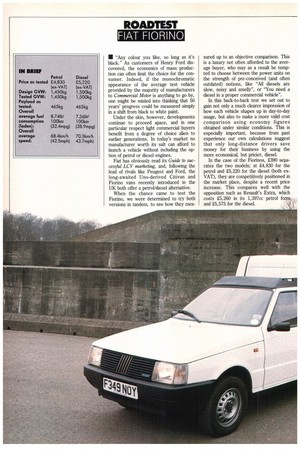
Page 65
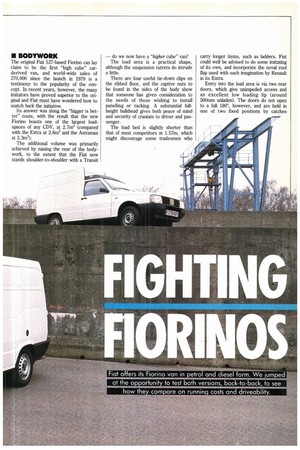
Page 66
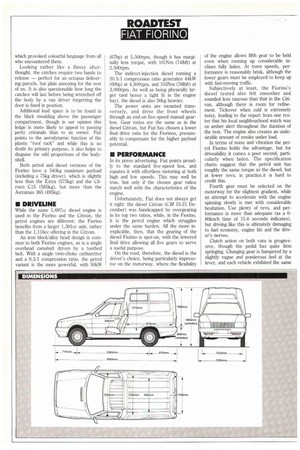
Page 67
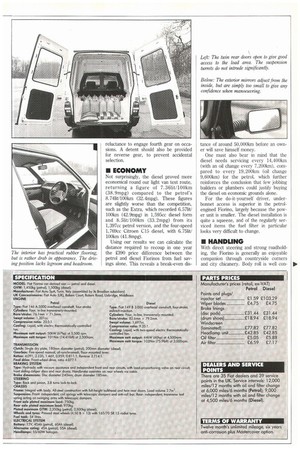
Page 68
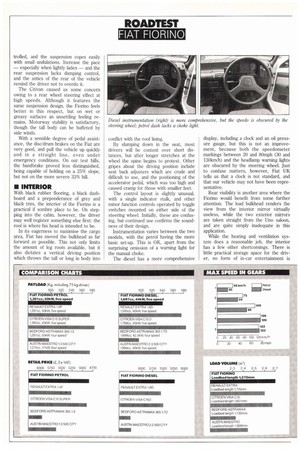
Page 69
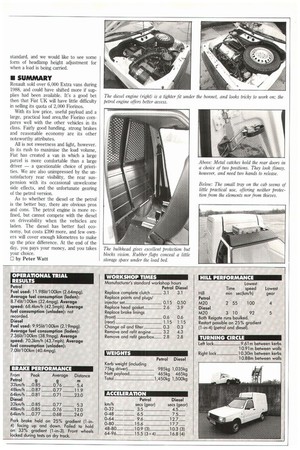
If you've noticed an error in this article please click here to report it so we can fix it.
As customers of Henry Ford discovered, the economics of mass production can often limit the choice for the consumer. Indeed, if the monochromatic appearance of the average test vehicle provided by the majority of manufacturers to Commercial Motor is anything to go by, one might be misled into thinking that 50 years' progress could be measured simply in a shift from black to white paint.
Under the skin, however, developments continue to proceed apace, and in one particular respect light commercial buyers benefit from a degree of choice alien to earlier generations. In today's market no manufacturer worth its salt can afford to launch a vehicle without including the option of petrol or diesel engines.
Fiat has obviously read its Guide to successful LCV marketing, and, following the lead of rivals like Peugeot and Ford, the long-awaited Uno-derived Citivan and Fiorino vans recently introduced in the UK both offer a petrolldiesel alternative.
When the chance came to test the Morino, we were determined to try both versions in tandem, to see how they mea sured up to an objective comparison. This is a luxury not often afforded to the average buyer, who may as a result be tempted to choose between the power units on the strength of pre-conceived (and often outdated) notions, like "All diesels are slow, noisy and smelly", or "You need a diesel in a proper commercial vehicle".
In this back-to-back test we set out to gain not only a much clearer impression of how each vehicle shapes up in day-to-day usage, but also to make a more valid cost comparison using economy figures obtained under similar conditions. This is especially important, because from past experience our own calculations suggest that only long-distance drivers save money for their business by using the more economical, but pricier, diesel.
In the case of the Fiorinos, 2390 separates the two models; at £4,830 for the petrol and £5,220 for the diesel (both exVAT), they are competitively positioned in the market place, despite a recent price increase. This compares well with the opposition such as Renault's Extra, which costs 25,260 in its 1,397cc petrol form and £5,575 for the diesel.
• BODYWORK
The original Fiat 127-based Fiorino can lay claim to be the first "high cube" carderived van, and world-wide sales of 270,000 since the launch in 1979 is a testimony to the popularity of the concept. In recent years, however, the many imitators have proved superior to the original and Fiat must have wondered how to snatch back the initiative.
Its answer was along the "bigger is better" route, with the result that the new Fiorino boasts one of the largest loadspaces of any CDV, at 2.7m3 (compared with the Extra at 2.6m3 and the Astramax at 2.3m3).
The additional volume was primarily achieved by raising the rear of the bodywork, to the extent that the Fiat now stands shoulder-to-shoulder with a Transit
— do we now have a "higher cube" van?
The load area is a practical shape, although the suspension turrets do intrude a little.
There are four useful tie-down clips on the ribbed floor, and the captive nuts to be found in the sides of the body show that someone has given consideration to the needs of those wishing to install panelling or racking. A substantial fullheight bulkhead gives both peace of mind and security of cranium to driver and passenger.
The load bed is slightly shorter than that of most competitors at 1.57m, which might discourage some tradesmen who carry longer items, such as ladders. Fiat could well be advised to do some imitating of its own, and incorporate the noval roof flap used with such imagination by Renault in its Extra.
Entry into the load area is via two rear doors, which give unimpeded access and an excellent low loading lip (around 500mm unladen). The doors do not open to a full 180°, however, and are held in one of two fixed positions by catches which provoked colourful language from all who encountered them.
Looking rather like a flimsy afterthought, the catches require two hands to release — perfect for an octopus delivering parcels, but plain annoying for the rest of us. It is also questionable how long the catches will last before being wrenched off the body by a van driver forgetting the door is fixed in position.
Additional load space is to be found in the black moulding above the passenger compartment, though in our opinion this ledge is more likely to appeal to passing petty criminals than to an owner. Fiat points to the aerodynamic function of the plastic "roof rack" and while this is no doubt its primary purpose, it also helps to disguise the odd proportions of the bodyshell.
Both petrol and diesel versions of the Fiorino have a 540kg maximum payload (including a 75kg driver), which is slightly less than the Extra (575kg) and the Citroen C15 (585kg), but more than the Astramax 365 (495kg).
• DRIVELINE
While the same 1,697cc diesel engine is used in the Morino and the Citivan, the petrol engines are different: the Fiorino benefits from a larger 1,301cc unit, rather than the 1,116cc offering in the Citivan.
An iron block/alloy head design is common to both Morino engines, as is a single overhead camshaft driven by a toothed belt. With a single twin-choke carburettor and a 9.3:1 compression ratio, the petrol variant is the more powerful, with 50kW (67hp) at 5,500rpm, though it has marginally less torque, with 101Nrn (74lbft) at 2, 50Orpm.
The indirect-injection diesel running a 20.5:1 compression ratio generates 44kW (60hp) at 4,500rpm, and 103Nm (761bft) at 3,000rpm. As well as being physically larger (and hence a tight fit in the engine bay), the diesel is also 50kg heavier.
The power units are mounted transversely, and drive the front wheels through an end-on five-speed manual gearbox. Gear ratios are the same as in the diesel Citivan, but Fiat has chosen a lower final drive ratio for the Fiorinos, presumably to compensate for the higher payload potential.
• PERFORMANCE
In its press advertising, Fiat points proudly to the standard five-speed box, and equates it with effortless motoring at both high and low speeds. This may well be true, but only if the chosen gear ratios match well with the characteristics of the engine.
Unfortunately, Fiat does not always get it right: the diesel Citivan (CM 15-21 December) was handicapped by overgearing in its top two ratios, while, in the Fiorino, it is the petrol engine which struggles under the same burden. All the more inexplicable, then, that the gearing of the diesel Fiorino is spot-on, with the lowered final drive allowing all five gears to serve a useful purpose.
On the road, therefore, the diesel is the driver's choice, being particularly impressive on the motorway, where the flexibility of the engine allows fifth gear to be held even when running up considerable inclines fully laden. At town speeds, performance is reasonably brisk, although the lower gears must be employed to keep up with fast-moving traffic.
Subjectively at least, the Fiorino's diesel tested also felt smoother and sounded less raucous than that in the Citivan, although there is room for refinement. Tickover when cold is extremely noisy, leading to the report from one tester that his local neighbourhood watch was on amber alert throughout the duration of the test. The engine also creates an undesirable amount of smoke under load.
In terms of noise and vibration the petrol Fiorino holds the advantage, but for driveability it comes a poor second, particularly when laden. The specification charts suggest that the petrol unit has roughly the same torque as the diesel, but at lower revs; in practice,it is hard to credit this.
Fourth gear must be selected on the motorway for the slightest gradient, while an attempt to accelerate with the engine spinning slowly is met with considerable hesitation. Use plenty of revs, and performance is more than adequate (as a 080krn/h time of 15.6 seconds indicates), but driving like this is ultimately damaging to fuel economy, engine life and the driver's nerves.
Clutch action on both vans is progressive, though the pedal has quite firm springing. Changing gear is hampered by a slightly vague and ponderous feel at the lever, and each vehicle exhibited the same reluctance to engage fourth gear on occasions. A detent should also be provided for reverse gear, to prevent accidental selection.
• ECONOMY
Not surprisingly, the diesel proved more economical round our light van test route, returning a figure of 7.36lit/100km (38.9mpg) compared to the petrol's 8.741iti100km (32.4mpg). These figures are slightly worse than the competition, such as the Extra, which recorded 6.571it/ 100km (42.9mpg) in 1,595cc diesel form and 8.51it/100km (33.2mpg) from its 1,397cc petrol version, and the four-speed 1,769cc Citroen C15 diesel, with 6.75lit/ 100km (41.8mpg).
Using our results we can calculate the distance required to recoup in one year the £390 price difference between the petrol and diesel Fiorinos from fuel savings alone. This reveals a break-even dis
tance of around 50,000km before an owner will save himself money.
One must also bear in mind that the diesel needs servicing every 14,400krn (with an oil change every 7,200km), compared to every 19,200km (oil change 9,600km) for the petrol, which further reinforces the conclusion that few jobbing builders or plumbers could justify buying the diesel on economic grounds alone.
For the do-it-yourself driver, underbonnet access is superior in the petrolengined Fiorino, largely because the power unit is smaller. The diesel installation is quite a squeeze, and of the regularly serviced items the fuel filter in particular looks very difficult to change.
• HANDLING
With direct steering and strong roadholding, the Florin° is generally an enjoyable companion through countryside corners and city chicanery. Body roll is well con trolled, and the suspension copes easily with small undulations. Increase the pace — especially when lightly laden — and the rear suspension lacks damping control, and the antics of the rear of the vehicle remind the driver not to overdo it.
The Citivan caused us some concern owing to a rear wheel steering effect at high speeds. Although it features the same suspension design, the Morino feels better in this respect, but on wet or greasy surfaces an unsettling feeling remains. Motorway stability is satisfactory, though the tall body can be buffeted by side winds.
With a sensible degree of pedal assistance, the disc/drum brakes on the Fiat are very good, and pull the vehicle up quickly and in a straight line, even under emergency conditions. On our test hills, the handbrake proved less distinguished, being capable of holding on a 25% slope, but not on the more severe 33% hill.
II INTERIOR With black rubber flooring, a black dashboard and a preponderance of grey and black trim, the interior of the Florin° is a practical if sombre place to be. On stepping into the cabin, however, the driver may well register something else first: the roof is where his head is intended to be.
In its eagerness to maximise the cargo area, Fiat has moved the bulkhead as far forward as possible. This not only limits the amount of leg room available, but it also dictates a vertical driving position which throws the tall or long in body into conflict with the roof lining.
By slumping down in the seat, most drivers will be content over short distances, but after longer stretches at the wheel the spine begins to protest. Other gripes about the driving position include seat back adjusters which are crude and difficult to use, and the positioning of the accelerator pedal, which was too high and caused cramp for those with smaller feet.
The control layout is slightly unusual, with a single indicator stalk, and other minor function controls operated by toggle switches mounted on either side of the steering wheel. Initially, these are confusing, but continued use confirms the soundness of their design.
Instrumentation varies between the two models, with the petrol having the more basic set-up. This is OK, apart from the surprising omission of a warning light for the manual choke.
The diesel has a more comprehensive display, including a clock and an oil pressure gauge, but this is not an improvement, because both the speedometer markings between 20 and 80mph (30 and 130krn/h) and the headlamp warning lights are obscured by the steering wheel. Just to confuse matters, however, Fiat UK tells us that a clock is not standard, and that our vehicle may not have been representative.
Rear visibility is another area where the Fiorino would benefit from some further attention. The load bulkhead renders the view from the interior mirror virtually useless, while the two exterior mirrors are taken straight from the Uno saloon, and are quite simply inadequate in this application.
While the heating and ventilation system does a reasonable job, the interior has a few other shortcomings. There is little practical storage space for the driver, no form of in-car entertainment is standard, and we would like to see some form of headlamp height adjustment for when a load is being carried.
• SUMMARY
Renault sold over 6,000 Extra vans during 1988, and could have shifted more if supplies had been available. It's a good bet then that Fiat UK will have little difficulty in selling its quota of 2,000 Fiorinos.
With its low price, useful payload and a large, practical load area,the Fiorino compares well with the other vehicles in its class. Fairly good handling, strong brakes and reasonable economy are its other noteworthy attributes.
All is not sweetness and light, however. In its rush to maximise the load volume, Fiat has created a van in which a large parcel is more comfortable than a large driver a questionable choice of priorities. We are also unimpressed by the unsatisfactory rear visibility, the rear suspension with its occasional unwelcome side effects, and the unfortunate gearing of the petrol version.
As to whether the diesel or the petrol is the better buy, there are obvious pros and cons. The petrol engine is more refined, but cannot compete with the diesel on driveability when the vehicles are laden. The diesel has better fuel economy, but costs £390 more, and few owners will cover enough kilometres to make up the price difference. At the end of the day, you pays your money, and you takes your choice.
0 by Peter Watt
































































































































